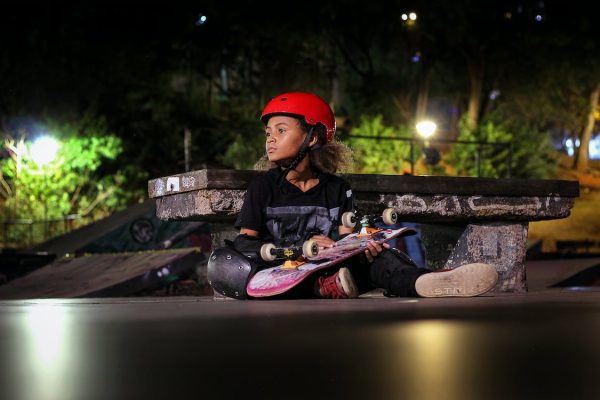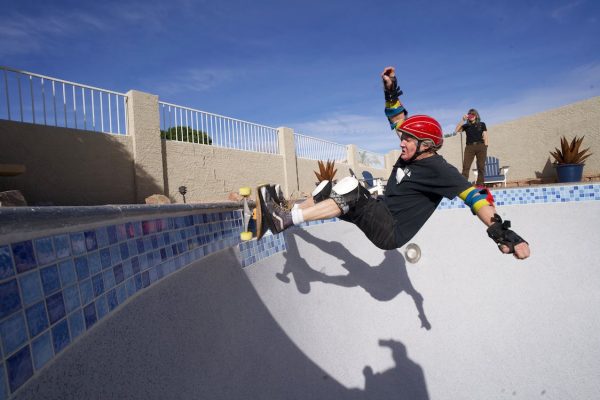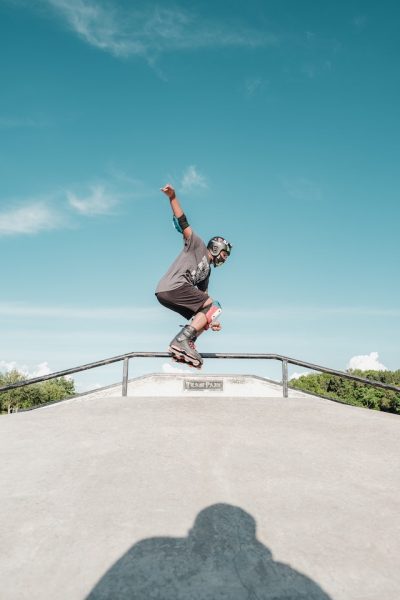Skateboarding Safely

As avid skateboard riders ourselves, we here at FamilyHype are passionate about helping others enjoy this thrilling sport safely. In this article, we’ll discuss the basics of skateboarding, the practice of wearing safety gear, safety locations to practice, and how to fall safely to minimize injuries. Additionally, we’ll provide tips on maintaining your new skateboard for optimal skateboarding performance and skateboarding etiquette points for responsible riders.
Skateboarding is a beloved sport and requires the utmost skateboarding safety precautions. When it comes to protective gear and safety tips, skateboarding riders should always wear a helmet, wrist guards, and knee pads to adhere to the skateboarding safety standards. Skateboard maintenance consists of regularly checking for any loose parts, repairing any damages, and replacing worn-out parts. Lastly, skateboarding etiquette includes respecting private property, being conscious of other skaters, and being aware of your surroundings.
These measures are essential for any skateboarder to follow and will help ensure your security while enjoying the sport. If you want to make your skateboarding journey smooth and enjoyable, follow the tips outlined in our article, and always remember to wear the appropriate protective gear!
Key Takeaways
Skateboard Practicing Safely
We will explore the fundamentals of skateboarding, covering everything from understanding the sport’s basics to proper etiquette. Wearing protective gear like helmet, wrist guards, elbow and knee pads, mastering correct skateboard falling techniques, and regularly maintaining your skateboard are all crucial for skateboarding safety standards. Skateboarders should also be mindful of their surroundings when choosing a place to ride, such as avoiding busy streets, crowded areas, and areas without adequate lighting.
We understand the importance of the right equipment for a successful skateboard riding experience. From skateboard decks to skateboarding safety gear, a skateboarder’s equipment is a major part of the sport and should be taken into consideration when heading out for a ride.
Skateboard Practice Basics
Before you can hit the pavement with confidence, it’s essential to grasp key skateboarding basics. These basics include balance, board control, and knowing how to fall safely. We encourage skateboarders to consider board choices wisely and learn trick techniques patiently. Wearing a helmet for the best safety is of utmost importance for the skateboarder.
The skateboarding journey doesn’t end here, though; understanding the equipment is equally crucial. This article will provide an in-depth look into why wearing protective gear, such as helmets, is essential, the types of skateboard protective gear available, and what skateboarders should consider when selecting the best safety gear.
By sharing feedback on their skateboarding experience, readers can also help foster a safe skateboarding environment and provide others with a good example of skateboarding safety tips. So, let’s delve into why wearing skateboard protective gear, like a helmet, wrist guards and pads is so important for a successful skateboarding journey.
Skateboarding
Wear Protective Gear To Avoid Skateboarding Injuries
When you’re shredding on a skateboard, don’t forget the importance of wearing protective gear; it’s like a personal suit of armor against scrapes, bruises, and more serious injuries. As skateboarders, we must be mindful of skateboard and fall gear durability and make sure we are selecting the right helmet. Safety should always come first!
To avoid skateboarding injuries, a person on a skateboard should wear protective gear, including a helmet that fits well, a multi-sport helmet, or sport helmet and stick to safe skateboarding areas, trying to land on the fleshy parts if they fall.
Wearing protective gear when skateboarding, such as closed-toe shoes and pads, is crucial to skateboarding safely and avoid injuries from cracked parts, sharp edges, metal boards, and potential falls, especially for younger skaters who may lose control or land on fleshy body parts, as it provides a safety barrier on the soft surface.
Skateboarding is a sport that requires boards, safety equipment, protective gear, and proper technique. Skateboards come in various shapes and sizes, and skateboard protective gear includes helmets, knee pads, elbow pads, and wrist guards. Regardless of the type of skateboard you use or the gear you have, it’s important to practice secured techniques to ensure your safety and the safety of those around you.
Wearing safety gear when skateboard riding is crucial to prevent skateboarding injuries or serious injuries; it’s one of the key skateboarding safety tips to avoid skateboard injuries.
Safe Skateboarding Practice

Safe Skateboarding
- As we navigate the world of skateboarding, it’s crucial to discuss where it’s safe for us to ride our boards. Let’s delve into the pros and cons of skate parks versus streets and why one might be a better choice than the other.
- For safe skateboarding, follow these safety tips – skateboarding protective gear must always be worn, learn proper techniques, and skate in safe areas to avoid accidents.
- Also, we can’t forget about understanding local skate laws. We must be well-informed to stay on the right side of regulations while enjoying our sport.
Skate Parks Vs. Streets
- You’re cruising down the sidewalk, feeling the wind in your hair and the board beneath your feet, but have you ever considered the differences between skateboarding on streets versus skate parks?
- Park designs are specifically built for riding, while street obstacles can be unpredictable. The presence of motor vehicles also makes the streets riskier when you ride a skateboard. An accident involving a motor vehicle could result in serious injuries. Safe skateboarding is paramount in all environments. Therefore, wearing a skateboard helmet that fits properly is essential. By understanding these differences, we can better protect ourselves and others. It’s important to take this awareness further and encourage our readers to explore local skate laws for additional skateboard safety and knowledge.
- When it comes to skateboarding, practicing safe techniques is essential. Skateboards are a form of transportation, entertainment, and even a sport for those who are passionate about it. Skateboards can be used in a variety of different ways, such as street skating, skate park skating, downhill skating, and even freestyle. Skateboarding practices and mastering the necessary skills and techniques are essential to ensure your safety and have fun while avoiding skateboarding injuries. All of these styles require different protective gear, skills, and techniques to stay secure and have fun.
- When skateboarding in a skate park or on the street, it’s important to have a good idea of your surroundings and the potential hazards. Skate parks have been designed specifically for skaters, with rails, ramps, and bowls to provide the necessary equipment and ensure a secure environment for skateboarding. Streets, on the other hand, have obstacles such as curbs, benches, and cars that can make street skating a bit more unpredictable.
- Supervised skate parks, with safety rules to enhance safety, are preferable to street skating due to the higher risk of head injury and most skate-related injuries, often associated with the slippery surfaces and wheels on streets.
- In addition, it’s important to remember that riding a skateboard isn’t allowed in many places and can be illegal in some areas. It’s best for experienced skateboarders who are into multi-sport activities to stick to skate parks and other designated skateboarding areas. Therefore, it’s crucial to check your local laws and regulations before engaging in this thrilling sport.
- Let’s take this awareness further by delving into understanding local skate laws next. By educating ourselves on the laws governing skating, we can ensure that we’re not only protecting ourselves but also safeguarding our families and friends who may be involved in skating as well.
Navigating Local Board Riding Laws
- Navigating local skate laws might feel like a bit of a maze, but it’s essential to have this knowledge in your back pocket. Understanding these laws can prevent potential legal penalties and ensure we’re always skating within our rights.
- We recognize the importance of practicing safe skateboarding and are committed to promoting integrity and respect within our community. To do so, let’s proactively secure skateboarding permits when needed.
- By being aware of these laws, skateboarders can ensure they are skating within their rights and avoid potential legal penalties. We must also remember to secure skateboarding permits if needed. Together, we can create a respectful skateboarding environment.

Skateboarding Practicing Safely
- Mastering the art of falling correctly may sound counterintuitive, but it’s a vital aspect of successful skateboarding. By learning and practicing skateboard fall techniques, we can significantly contribute to injury prevention and help ensure skateboarding remains an enjoyable activity. This involves knowing how to distribute impact to minimize harm during a spill, such as rolling, tucking, and bracing.
- To fall safely when skateboarding, wear heavy-duty gear, avoid wet weather, be cautious of hard and sharp objects, and be prepared if the vehicle suddenly slows to prevent injuries and visits to hospital emergency rooms. To practice skateboarding safety tips, skateboarding protective gear should always be the priority, and learn how to fall properly to prevent injuries.
- Additionally, skateboarders should always use the right protective gear, such as helmets, elbow pads, and knee pads. As we get better at this crucial skill, let’s not forget that regularly servicing our boards helps ensure our rides remain as smooth as possible.
- Ultimately, these steps can help us all become experienced and confident skateboarders.
Upkeep Of Your Longboard
- Keeping your skateboard in top-notch condition isn’t just about aesthetics; it’s a surefire way to enhance performance and prolong its lifespan. Deck customization and wheel selection are key parts of this process. It’s important to carefully select wheels that match our skating style and skill level while adding a personal touch with deck customization. This mindful care shows respect not only to ourselves but also to other skaters.
- Skateboarding is more than just a sport, it’s a lifestyle, and proper skateboard etiquette is essential for showing respect to yourself and others. Maintaining your skateboard with the right gear, such as the appropriate sized wheels and grip tape, helps ensure you’re not only looking and performing your best but also that you’re keeping yourself and other skaters secure.
- By taking the time to customize your board and selecting the perfect wheels for your skill level, you can maximize your performance and create a truly unique skateboard that reflects your style and personality.
Longboard Riding Etiquette
- Skating is a great way to stay active and have fun. At the same time, understanding the unwritten rules of the skate park is essential to making your ride enjoyable and respectful to other skaters. From respecting other skaters’ space to waiting our turn on ramps and obstacles, board etiquette is key.
- Etiquette in skate sports also involves exceeding safety standards and using high-quality protective gear like elbow pads to reduce injuries, and being aware of emergency medical care, as recommended by the Consumer Product Safety Commission.
- Practicing proper etiquette, being mindful of others, including skateboarders and children, and riding with your front foot forward to ensure a respectful and enjoyable experience for everyone. When it comes to skateboarding, it’s important to be aware of others, giving them space to ride freely without interference. It’s also important to wait our turn on skateboard ramps or obstacles, showing respect for everyone’s time and efforts. Let’s all work together to make the skate park an enjoyable place for everyone.
Safe Skating
Conclusion
- We’ve covered the fundamentals of skateboarding, from understanding the sport’s basics to learning proper etiquette. Wearing protective gear, mastering correct falling techniques, and maintaining your skateboard regularly are all crucial for a smooth and enjoyable skateboard ride.
- To stay safe while skateboarding, always wear protective gear, follow safety skateboarding rules, and stay aware of your surroundings.
- It’s also important to choose appropriate places to ride, as skateboarders should always be aware of their surroundings. From skateboard decks to safety gear, a skateboarder’s equipment is a major part of the skateboard sport and should be taken into consideration when heading out for a ride.
Frequently Asked Questions (FAQs):
What Is Skateboarding Safely?
Skateboarding safely means wearing protective gear, practicing in safe areas, and following basic safety skateboarding rules to stay safe while skateboarding.
The number one tip is to wear protective gear, such as knee and elbow pads, wrist guards, and a properly fitting helmet. A multi-sport helmet is also okay. Wearing essential protective equipment drastically decreases the chances of getting severe injuries from skateboard riding. It would help if you also avoided homemade skateboard ramps. Head to supervised skate parks instead. Another tip is to never ride with more than one person on the board.
What Should I Practice When Learning To Skateboard?
Start by perfecting your skateboard balance. Practice balancing at home, use your arms to stay steady, find smooth surfaces to ride on, and always wear protective gear to avoid injury. You need to get used to the feeling of having wheels underneath you. This also involves practicing proper foot positioning and overall posture, as well as managing your center of gravity. Once you’ve mastered these things, you can start practicing how to move.
How Do You Prepare For Longboard Riding?
If you want to try skateboard riding, it’s important to have all the essentials ready before you begin. This includes buying a skateboard and well-fitting safety gear for the different parts of your body. Essential protective equipment includes a helmet, wrist guards, knee pads, and elbow pads.
Also, make sure you study the rules of the area you plan to skate in. If a child wants to learn how to ride a skateboard, make sure they’re always under adult supervision.
How Often Do Riders Get Injured?
Riders often get injured if they don’t follow safety tips – skateboarding can be risky, so using proper gear and learning safety tips is essential to prevent accidents.
Studies say over 200,000 people get injured in skateboard riding accidents on an annual basis. However, most of these incidents are minor. You can reduce your risk of injury by following skateboard riding tips.
How Do You Not Break Your Bones When Board Riding?
Wearing wrist guards, knee and elbow pads, and other protective gear can all enhance skateboard riding safety. Also, to avoid serious injury when skateboard riding, make sure not to skateboard in wet weather, use your pushing foot properly, land on the fleshy parts of your body, consider professional help for guidance, and seek immediate assistance at the emergency room if needed. You should also learn how to fall properly to protect your limbs from impact. Doing so also prevents head injuries and facial injuries like a broken nose or jaw.
Does Board Riding Damage Joints?
It can likely cause wear and tear on your joints over time, but skateboard riding isn’t necessarily bad for them as long as you stay safe and keep them strong. Skateboard riding, with its irregular surfaces, may pose a risk of wrist fractures, but with proper technique and basic skills, serious joint defects are less likely.
What’s The Proper Board Riding Stance?
There are two different skateboard riding stances: goofy and regular. The one you should use depends solely on which makes you feel more comfortable. The only difference between the two is foot positioning. Regular riders skate with their left foot on the board, pushing with the right. Goofy-foot riders keep their right foot on the board.
How Do Skaters Fall And Not Get Hurt?
Skateboard riding is a fun and exciting activity, but safety should always come first. Wearing safety gear is a must, regardless of skateboard riding skill, as well as learning how to protect your head and limbs in case of a fall.
Is Skateboard Riding A High-Risk Sport?
According to experts, skateboard riding is no more dangerous than other similar sports. That said, there are always risks involved when it comes to these activities. Injuries happen. It’s up to us to take the necessary precautions. Also, skateboard riding is a high-risk sport, especially when kids do tricks, ride without proper shoes, or skateboard near traffic, which is why parents should focus on safety and skill development.
Is Skateboard Riding A Good Form Of Exercise?
Yes. Skateboard riding improves muscle strength, balance, and agility. Skateboarding engages different muscle groups, including your core muscles, hamstrings, and glutes. It also helps improve cardiovascular strength.
